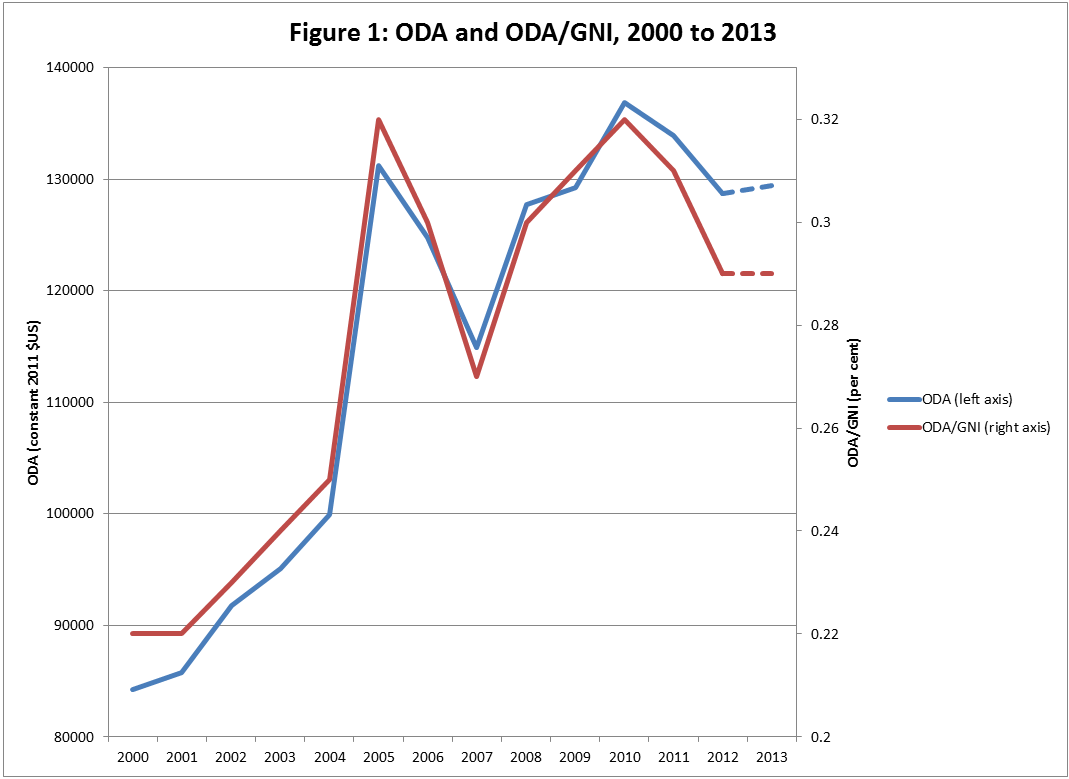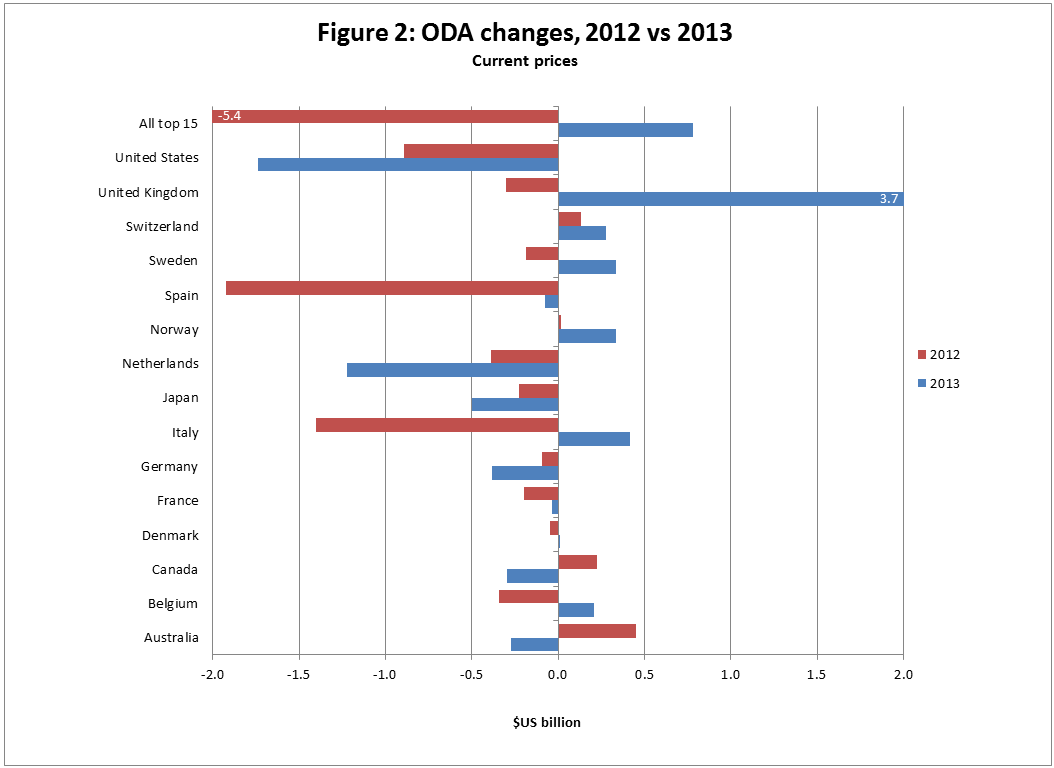Global aid grew by more than 60 per cent over the decade to 2010, reaching $136.9 billion.[1] But in 2011 and 2012, it fell by a total of six per cent—more than $8 billion. Will it continue on this steep downward path in 2013, or stabilise and recover? The OECD will provide a preliminary answer to that question in April 2014, but we’re impatient.
To hazard our own answer to the question, the Development Policy Centre has analysed, for the second year running, what the largest member countries of the OECD’s Development Assistance Committee (DAC) have said publicly about their spending intentions. Our results are summarised below and presented in more detail in the Development Policy Centre’s latest policy brief, ‘Global aid in 2013: a pause before descending’ [pdf].
Surprisingly, nobody else does this kind of forecasting. The OECD’s Development Cooperation Directorate forecasts levels of what it calls ‘country programmable aid’ (CPA). However, CPA captures only about half of all spending from Official Development Assistance (ODA) budgets and is not useful, or indeed intended to function, as a measure of donors’ fiscal effort. In addition, the OECD’s CPA forecasts for each of the last two years have been quite wide of the mark, erring on the side of optimism. For example, the OECD predicted CPA would grow by six per cent in 2012 but it actually fell by one per cent. For 2013, the OECD is predicting a nine per cent growth in CPA, which again looks optimistic. Our 2012 forecasting effort, by contrast, gave an accurate result: a four per cent decrease.
We’re interested in ODA rather than CPA. Donor governments think and budget in terms of ODA and it is the best measure of fiscal effort in favour of international development. We look at information that is available publicly on the 2013 ODA spending intentions of the 15 largest donors, who account for about 95 per cent of total DAC ODA, and we compare this with the corresponding information available in the early part of 2012 on the same donors’ 2012 spending intentions. In other words, we are looking at changes from budget to budget. On this basis, we can project a percentage change for a large proportion of global ODA in 2013, which is likely to be reflected quite closely in the percentage change for all ODA in 2013.
Our analysis of information on projected ODA spending in calendar 2013[2] indicates that global aid might well stabilise or even increase a little in real terms—less than one per cent—in 2013. The figure below summarises.
For total DAC ODA, we estimate the likely 2013 outcome to be between $126 billion and $127 billion—our mid-point estimate is $126.3 billion (these and subsequent figures are all expressed in 2012 prices). This would be a 0.6 per cent or $700 million increase on the 2012 outcome, which was $125.6 billion. We estimate the combined ODA/GNI ratio for DAC donors will remain at 0.29 per cent, its 2012 level. (It takes an additional $4 billion or so to achieve an increase of one basis point in the aggregate ratio.)
 This predicted pause in the decline of aid is entirely due to the unprecedented and sudden increase in the UK’s aid budget in 2013, which will jump from 0.56 to 0.7 per cent of the UK’s GNI in a single year. Without this, global aid would likely have fallen by another three per cent in real terms in 2013.
This predicted pause in the decline of aid is entirely due to the unprecedented and sudden increase in the UK’s aid budget in 2013, which will jump from 0.56 to 0.7 per cent of the UK’s GNI in a single year. Without this, global aid would likely have fallen by another three per cent in real terms in 2013.
The figure below summarises expected changes in ODA disbursements in 2013, relative to 2012, for the 15 largest DAC donors. ODA from the 14 non-UK donors is projected to fall by $3.2 billion. This fall is $500 million less than the projected growth of UK aid, which is $3.7 billion.
 Research suggests that in the wake of a significant banking crisis or recession, aid budgets will continue to fall over a substantial period of time. A working paper prepared by staff of the World Bank which studied OECD aid from 1977 to 2007 found that after a crisis a donor country’s aid falls by an average of 20 to 25 per cent, relative to the counterfactual, and improves only a decade after the crisis hit. Thus it must be considered unlikely that the projected 2013 pause in the decline of ODA will be followed by a recovery.
Research suggests that in the wake of a significant banking crisis or recession, aid budgets will continue to fall over a substantial period of time. A working paper prepared by staff of the World Bank which studied OECD aid from 1977 to 2007 found that after a crisis a donor country’s aid falls by an average of 20 to 25 per cent, relative to the counterfactual, and improves only a decade after the crisis hit. Thus it must be considered unlikely that the projected 2013 pause in the decline of ODA will be followed by a recovery.
Our forecast, like any other, should be taken with a sizeable grain of salt. Although we got the aggregate growth change right last year, we missed the mark for several individual donors. However, we have better information this year for some key donors. In any case, we think our effort is probably closer to the mark than the OECD’s forecast for a nine per cent growth in country programmable aid in 2013. What officials say to the OECD in survey responses is less likely to reflect reality than what their governments publish in budget documents.
Robin Davies is Associate Director of the Development Policy Centre, Crawford School of Public Policy, The Australian National University. Michelle la O’ is a Research Assistant at the Development Policy Centre.



Robin and Michelle –
Thanks a lot for your effort on this, and congratulations to the Centre on a remarkably accurate forecast for total aid in 2012!
I wonder if you might be planning to do this exercise earlier in the year next time? If so we would be happy to reference your estimates in our annual press release on the preliminary ODA numbers, which as you say come out in April. Otherwise, we will bear your research in mind when considering projections.
Your point that CPA estimates have not proven good guides to the following year’s ODA numbers is well taken. We may need to re-think how we present the CPA numbers in the press release, and check where the forecasts are going off-track. However, we still think CPA forward estimates should be of more use to developing country governments than ODA estimates. CPA focuses on resources over which developing countries have some control, leaving out debt relief and some in-donor costs. Our Forward Spending Survey provides a lot more detail about planned CPA numbers than we can put in the press release, including estimates of spending by multilateral agencies.
Overall, I find your estimates for 2013 ODA very plausible, and can only admire your boldness in specifying your prediction to within a $1 billion range. Let’s see how it pans out, but a pause on the way down seems right, given that most donors will be trimming but the UK ODA will surge. By the way we saw a similar “dead cat bounce” in total DAC ODA after the last major global downturn in the early 90s, with aid falling sharply in 1993, but rising slightly in 1994 before dropping again for another three years.
On the processes behind the fall, I would urge attention not only to recession but to its impact on revenue. For me the budget balance is the middle term between recession and aid cuts. It also explains the “amplification factor”: being discretionary spending, aid is prone to larger cuts than other items in fiscal consolidation exercises, as I mentioned in my talk at the Centre in July [https://devpolicy.org/in-brief/simon-scott-does-development-assistance-have-a-future/].
All the best to your and your colleagues – you are doing a marvellous job of covering the development scene!
Simon Scott, Head, Statistics and Development Finance Division, OECD
Simon,
This detailed comment is much appreciated. In response to your question about the timing of future such exercises, let’s first see if our boldness results in embarrassment and ridicule. If not, we’ll aim to put something out earlier next year — not least because things might be a little more stable in the local scene — but I don’t think we’d have a good enough information base until around late May 2014 when all relevant budget announcements have been made.
Robin
…of course he reason for the sharp rise is two-fold, one is the security crisis of 2001-2005 (now diminished) and the second is the rise of BRIC donors (mainly China) through the 2000s to date. The question is do the DAC donors have the stomach for or care for an aid/influence fight with the non-DAC donors and aid recipients on the nature and direction of third world development, and do the voting public care.